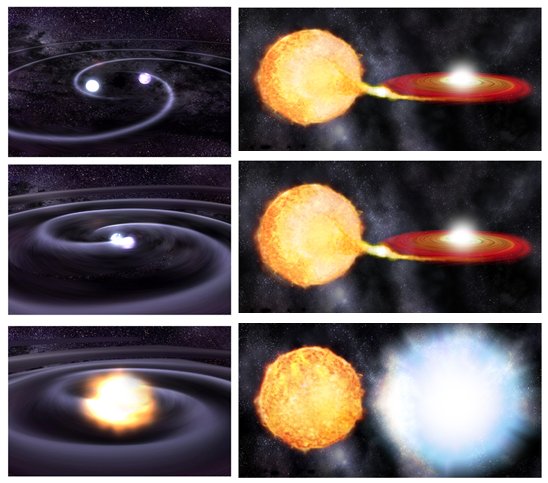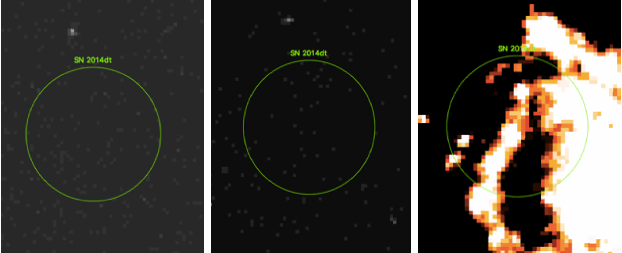Supernova Research
A peculiar, new class of supernovae called Type Iax (SNe Iax) was discovered in 2002. Among these Type Iax supernovae is Supernova 2014dt (SN 2014dt). SN 2014dt existed in the Messier 61 galaxy at a distance of D = 12.3 Mpc, making it the closest type Iax yet discovered. SNe Iax are similar to the more understood, and earlier discovered, Type Ia supernovae. Type Ia and Type Iax supernovae both lack Hydrogen and have very similar optical properties. The two types of supernovae are also both formed from binary star systems consisting of a white dwarf (WD) and another companion star. The companion star is often a, Red Giant Star(RGS), a G-Type Dwarf Star, forming a single degenerate progenitor, or a white dwarf (WD) forming a double degenerate progenitor (Fig. 1). However, Type Iax and Ia also have very distinct differences. Type Iax supernovae have companion stars that loose it's outer hydrogen and is left dominated by helium. The helium that is left from the companion star funnels into the white dwarf subsequently gaining enough mass that it's outward pressure is no longer able to counteract the force of its own gravity. In type Ia supernovae, the process is similar, however the white dwarf isn't restricted to gaining only helium (Foley 2013). SN Iax are far less luminous than Type Ia as well. SN Iax has expansion velocities that range from 2000-8000 km/s in comparison to SNe Ia which has expansions velocities around 10000-20000 km/s (Jha 2006, Liu 2015) This low luminosity makes Type Iax supernovae more difficult events on which to collect data(Foley 2013).

The goal of my research is to constrain the immediate explosion's environment. The ultimate objective is to identify the companion star of SN 2014dt. We will analyze radio and x-ray data to determine the companion star of SN Iax 2014dt. The x-ray and radio data will be collected from different pieces of literature, and in majority, from Laura Chomiuk's, A Deep Search for Prompt Radio Emission From Thermonuclear Supernovae with the Very Large Array. From this paper, we will particularly be looking at the flux density, luminosity, and frequency of different SNe Iax and SNe Ia. Collecting this data will help conclude the emission model that identifies the density of the matter surrounding the 2014dt SNe. From this information, the type of star companioning 2014dt could be determined.

We will collect radio observations for the luminosity and flux density of different Ia and Iax supernovae largely from Laura Chomiuk's 'A Deep Search for Prompt Radio Emission from Thermonuclear Supernovae with the Very Large Array." These radio emissions were taken using the Very Large Array (VLA) over a period 20 years. The data we collected for 2014dt at several different frequencies comes from the Chandra Telescope. When the luminosity and flux density of Ia and Iax supernovae were compared with SN 2014dt, it could be concluded that the environment surrounding SN 2014dt resembled type Iax and type Ia supernovae that had very little or a lot of material surrounding them. From this, we found that the environment around 2014dt was clean or very dirty and thus the progenitor system is predicted to be a double degenerate system or single degenerate system.
In correspondence with the radio data, the x-ray data lead us to similar conclusions. With the x-ray detections we will find that the environment around the SN 2014dt was either clean or dirty. Once again, leading to a single or double degenerate scenario. We also were able to make the conclusion that these x-rays indeed were the from the source of SN 2014dt.Using SaoImage DS9 software, we gathered the amount of photons in SN 2014dt and were able to determine if a detection existed by comparing the background data with the source data (Fig2.)
This data will give a probability that determines if the detection of x-rays were more than likely to have been produced by using Poisson Statistics(Eq1.) this data will give the a probability that determines if the detection of x-rays were more than likely to have been produced by 2014dt. At the end, we hope to learn about the progenitor of SN 2014dt, the closest Type Iax supernova to date, and as a result learn more about Type Iax supernovae in general to better study these events in the future. 